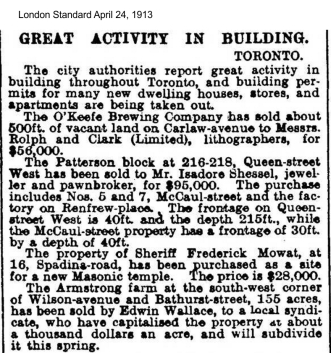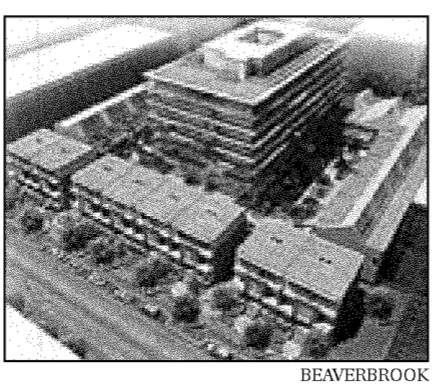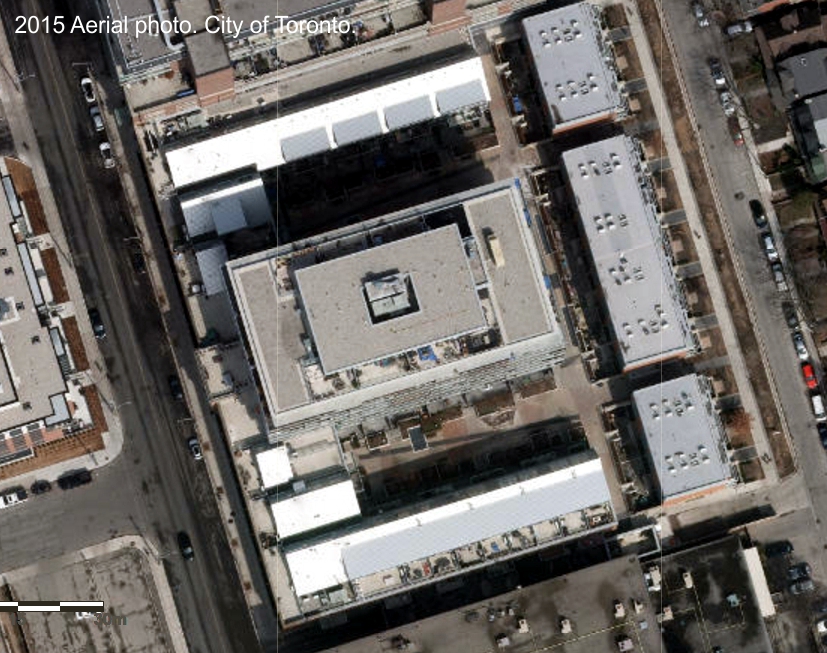
If you had stood at the corner of Queen and Carlaw in 1910, you wouldn’t see many factories except Phillips Manufacturing Co. Ltd. on the west side. The land on the east side was owned by wealthy brickyard owner John Russell. A City Alderman, he somehow failed to pay his municipal property taxes. The City of Toronto seized and sold his land between Carlaw and Boston. Russell fought back, but lost at the Privy Council in London, England, the last court of appeal in those days. In 1912 the City of Toronto used that land to develop Carlaw as an industrial artery in the East End. Manufacturers quickly seized the opportunity.
By 1921 factories with belching smokestacks dominated Carlaw. Labourers filled Carlaw, coming to work to the sound of factory whistles and going home at shift change. In the minds of residents, the noise, pollutions and jobs naturally went together and were welcome. Not that people did not want higher wages and better working conditions.


 The birth of the new factory involved some “hard labour” as the ironworkers and plasterers went out on strike and the other union men, bricklayers, plumbers and electricians, walked out in sympathy. A general strike would have threatened Toronto’s building boom.
The birth of the new factory involved some “hard labour” as the ironworkers and plasterers went out on strike and the other union men, bricklayers, plumbers and electricians, walked out in sympathy. A general strike would have threatened Toronto’s building boom.
So let’s stand back and take a good long look at this building. While this is a metaphor and I hope you enjoy this article, going to Carlaw and actually looking is even better.


Basic Form
The original 1913 factory consisted of two storeys on a raised base. The Rolph-Clark-Stone Building’s ferro-concrete frame dictated a basic box form, but allowed architects to use classical details for decoration. Toronto’s fine red brick clads the walls and the trim is brick and cast stone (artificial stone made with cement). The post and beam construction meant that the columns and bricks were non-structural, no longer load-bearing. The longest side of the structure fronts onto Carlaw Avenue and the back side fronts onto Boston Avenue.
Edwardian Classicism
The Rolph-Clark-Stone Building is identifiable as an Edwardian Classicist design by its front façade’s symmetrical massing, regular arrangement of windows and monumental central front entrance or frontispiece. Rolph-Clark-Stone, like other Edwardian Classicist factories, has a simple, balanced design, a straight roofline and sparse detailing compared to its predecessors. The cornice is simple. Most doors and windows have flat cast stone lintels. The walls are smooth and have many windows. For more info about Edwardian Classicism in Ontario see:
http://www.ontarioarchitecture.com/Edwardian.htm
For some examples of Edwardian Classicist industrial design walk up Carlaw Avenue but also see this slideshow:
A Grand Entrance
 The Carlaw street façade is organized into three sections with an elevated frontispiece in the centre. The façade on the west side dominates the passerby with its scale and design. Everything is meant to impress. This façade is the face of the building the one that the public sees. The centrally placed frontispiece is meant to convey the beauty, but also the importance of the lithography company and the art itself. The frontispiece is a three-bay structure separated by four two-storey fluted “engaged columns”. These columns are attached to the wall so that only part of the columns projects from the wall. Corinthian capitals crown the columns, drawing on Classical Greek and Roman architecture. These ornate capitals or column heads have a design with ancient design based on acanthus leaves, a design familiar to any educated gentleman of the day. At the base of the principal façade with its doorways and columns are three round arches with cast stone surrounds (mouldings).
The Carlaw street façade is organized into three sections with an elevated frontispiece in the centre. The façade on the west side dominates the passerby with its scale and design. Everything is meant to impress. This façade is the face of the building the one that the public sees. The centrally placed frontispiece is meant to convey the beauty, but also the importance of the lithography company and the art itself. The frontispiece is a three-bay structure separated by four two-storey fluted “engaged columns”. These columns are attached to the wall so that only part of the columns projects from the wall. Corinthian capitals crown the columns, drawing on Classical Greek and Roman architecture. These ornate capitals or column heads have a design with ancient design based on acanthus leaves, a design familiar to any educated gentleman of the day. At the base of the principal façade with its doorways and columns are three round arches with cast stone surrounds (mouldings).
If this is all Greek to you, you’re right – a lot of our architectural terms come from the ancient Greeks. For an explanation of terms, go to Buffalo’s great architectural dictionary:
http://www.buffaloah.com/a/DCTNRY/vocab.html#e
Guests entered the Rolph-Clark-Stone Building through the main door at the centre arch. Inside they found an equally impressive entrance lobby marked by more Classical detailing, vaulted ceilings and with what can only be described as a magnificent wooden grand staircase that climbs in two beautiful spirals. There are two more doors on the Carlaw side of the building — at the north and south ends, and, while they are handsome, they were for more day-to-day use.
The three tall flat-headed windows in the second storey are huge and inspired by Roman designs. The west façade also has 18 bays on either side of the frontispiece with many large steel sash windows. The whole building speaks of balance and symmetry. The flat-headed windows on the north and south sections of the western façade have cast stone sills. Concrete band courses unify the building, carrying your eyes across the window heads. There are large windows in the north and south sections of the west façade as well.
The frontispiece is topped by an entablature, the horizontal superstructure supported by giant, over-sized engaged Corinthian piers. The frieze is usually decorated with sculpture, but, in this case, is decorated with ghosted lettering spelling: ROLPH CLARK STONE.

The cornice of the Rolph-Clark-Stone Limited Building has a cast stone coping. This top course forms a protective cap against the weather and stretches along the Carlaw street wall and wraps around the south side of the building. As with the Kent-McClain Building, the cornice is important. While the pedestal or base of the building grounds it; the cornice acts as a stop, giving visual completion to the building. These elements say, “Here I begin and here I end” like a punctuation mark at the finish of a sentence. Edwardian cornices were much simpler than the late Victorian ones in this advertisement from 1898:

Many older buildings are missing their cornices and the loss is like an amputation. While passersby might not be able to say just why the building “doesn’t look right”, they can spot ugly.

The band of concrete across the lintels of the ground floor not only unifies the building by leading the eye horizontally along the brick-faced façade. It is also a subtle reference to the concrete floor of the second storey, articulated the interior on the exterior.

Saw Tooths


The factory incorporates a row of “saw tooth” on its roof. This roof design is most commonly seen on older factories.

The saw toothed windows faced north. They filtered the soft northern light and avoided glare, perfect for a graphic design firm like Rolph-Clark-Stone Ltd.

What the Building Was Trying to Say
201 Carlaw Avenue communicated the stability of Rolph-Clark-Stone Limited and the firm’s aesthetic sense. The design speaks of orderliness and authority. The Rolph-Clark-Stone Limited Building says, “We are rational, solid, secure and modern and we are here to stay.”
But it wasn’t true. Rolph-Clark-Stone Ltd. is gone, but the factory remained.
Printing Factory Lofts
The Printing Factory Lofts were built over the old Rolph-Clark-Stone Building. The Printing Factory Lofts project preserves three façades and incorporates significant portions of the original factory building into the project including the classical main entrance portico that opens to a grand wooden staircase. The land was purchased in 2004 for eight million dollars. The City of Toronto approved the construction of the Development in 2006. The prices ranged from $179,900 to $510,900 when the condo units first went on the market in October 2006 in pre-construction sales. The City of Toronto designated 201 Carlaw as a Heritage Building in 2007, one of only two on Carlaw — the other is the Toronto Hydro Transformer Building. Construction of the Printing House Lofts ended on May 12, 2010.
Although the front doors were replaced, much of the original entrance was kept.
It’s extraordinarily ornate, it’s all original…It’s going to be one of the nicest entranceways and lobbies of any condominium in Canada.
Brad Lamb, Brad J. Lamb Realty Inc., quoted in The Globe and Mail, November 3, 2006
They not only maintained the façade but also incorporated the old factory’s sawtooth roof with skylights into the two storey loft units with their exposed concrete ceilings, polished concrete floors, exposed metal ductwork and brick walls. The builders removed the centre portion of the factory, tearing down 65 per cent of the original factory. In its place they build an eight-storey glass tower, two garden courts and a series of townhouses that face Boston Avenue to the east.


Beaverbrook Homes (now Averton Homes) developed the old abandoned factory into an upscale condominium with lofts. The architectural firm was Chandler Graham / Montgomery Sisam Architects. The structural engineer firm was Blackwell Bowick Engineering and the mechanical engineer firm was Novatrend Engineering Group Ltd. The architects removed the centre part of the factory to create an eight storey glass tower, two garden courts and townhouses facing Boston Avenue. Brad Lamb was the realtor that marketed the newly created condominium project. This brought 254 new housing units to what was in the 1990s a brownfield of abandoned buildings and lost jobs.

The Printing Factory Lofts received the Paul Oberman Award for Outstanding Achievement in the Field of Architecture and Design at the 2011 Pug Awards – the 7th Annual People’s Choice Awards for Architecture. The Printing Factory Lofts also won a 2011 Toronto Urban Design Awards honorable mention.
To see what the Printing Factory Lofts look like today go to:
For more about the architecture of the Printing Factory Lofts see:
http://www.archdaily.com/148969/
Loss and Profit
Standing here in 2016, I juggle in my mind and heart, the loss to the East End that the adaptive reuse of Carlaw Avenue’s industrial buildings signifies and the profit to our community.
Remember the industrial Carlaw of early days and all the lost blue collar jobs. In my mind I am still standing at my work station, hearing the roar of the machinery in spite of my ear plugs and smelling the inks and breathing in the paper dust. My muscles were strong from moving box after box of flyers, maps, booklets and newsletters. I remember the ache of standing on a concrete floor for eight hours or the many hours of a double shift.
 We can argue that talented architects, creative designers, and flexible and sophisticated developers have profited Leslieville by repurposing empty, run-down factories, like this, into upscale condominium lofts. The City Plan only allows mid-rises like the Rolph-Clark-Stone Building so that a vibrant street life is fostered and glass towers don’t overshadow Leslieville. According to City Planners “a mid-rise building is generally taller than four storeys, but no taller than the width of the adjacent street right-of-way (i.e. typically between 5 and 11 storeys).” For more info see
We can argue that talented architects, creative designers, and flexible and sophisticated developers have profited Leslieville by repurposing empty, run-down factories, like this, into upscale condominium lofts. The City Plan only allows mid-rises like the Rolph-Clark-Stone Building so that a vibrant street life is fostered and glass towers don’t overshadow Leslieville. According to City Planners “a mid-rise building is generally taller than four storeys, but no taller than the width of the adjacent street right-of-way (i.e. typically between 5 and 11 storeys).” For more info see
http://www1.toronto.ca/wps/portal/contentonly?vgnextoid=4c06968dea37e410VgnVCM10000071d60f89RCRD
 These condos draw in a vibrant new population of young, affluent people while respecting the history of the neighbourhood. These newcomers fuel the booming businesses along Queen Street, driving Leslieville’s Renaissance and firing up the real estate market for detached homes and duplexes on the surrounding streets. Property values have soared with real estate prices and the cost of a Leslieville cup of java.
These condos draw in a vibrant new population of young, affluent people while respecting the history of the neighbourhood. These newcomers fuel the booming businesses along Queen Street, driving Leslieville’s Renaissance and firing up the real estate market for detached homes and duplexes on the surrounding streets. Property values have soared with real estate prices and the cost of a Leslieville cup of java.

A Landmark Building
We have a love-hate relationships with factories which may explain why so few are recognized as Heritage Buildings or have plaques. Carlaw Avenue is a street of such lost lovelies. I love this street and this building, but I hate how it is changing so quickly that I hardly recognize the old neighbourhood.
The Rolph-Clark-Stone Building, over a century old, existed in a grimy but elegant harmony with its industrial neighbours such as the Palmolive and Wrigley factories. Carlaw was a rundown “brown field” of empty buildings in the 1980s when I moved here. I share the Old East End’s blue collar history.
It is easy to argue that the Rolph-Clark-Stone reuse as the Printing Factory Lofts maintains the visual integrity necessary for it to convey its significance and heritage value. Yet many of us still remember those who waited in long lines at the unemployment insurance office. Pogie, no matter how much, never replaced the vanished jobs on Leslieville’s main industrial drag. Leslieville’s renaissance has brought new jobs, high paying jobs for some, minimum wage service industry (often part-time) jobs for others.
The bricks are no longer coated with decades of coal dust and industrial grime.The greasy spoons are disappearing, replaced by cafes with armchairs and baristas. We will continue our walk up Carlaw in our “time machine” and I hope you will follow us.
Your comments, memories and stories are welcome here, just email to the Leslieville Historical Society at:
leslievillehistory@gmail.com
The Heritage Analysis Report: Carlaw and District Landscape and Public Realm Improvements, March 2016, prepared for the City of Toronto by Unterman McPhail Associates can be downloaded here as a pdf:
For more about proposals for the future of Carlaw Avenue, see:
http://www.toronto.ca/legdocs/mmis/2014/te/bgrd/backgroundfile-72579.pdf
http://www.carlawdundas.ca/document/carlaw-dundas-heritage-analysis-report-march-2016
For more information on the architecture of this building go to:
http://www.toronto.ca/legdocs/mmis/2007/te/bgrd/backgroundfile-1048.pdf
http://www.archdaily.com/148969/
http://urbantoronto.ca/news/2011/06/pugs-reward-torontonians-favourite-new-buildings
http://app.toronto.ca/HeritagePreservation/details.do?folderRsn=2434016&propertyRsn=242328








My dad, Bill Rivers, worked there for over 30 years and I Cheryl Rivers Boyes worked there for a couple of years right after college…..this beings back incredible memories…
I would like permission to include a copy of a picture from this page of the Rolph-Clark-Stone building in my upcoming book about John R. Seeley, an important Canadian Scholar, who worked there during the 1930’s. The book is to be published by Academic Studies Press in Boston.
Please let me know, and thanks for your help, Paul
Hello Paul,
I’m not clear about which picture it is you wish to use. Could you email me at leslievillehistory@gmail.com and attach a pdf or jpg of the picture and I will get back to you.
Joanne
My mother, Helene LaPlante, and her brother, Arnold, worked at Rolph-Clark-Stone for years. She was a graphic artist designing greeting cards (before women did such work) while Arno was an electrician until well into the sixties – the nineteen-sixties, that is. I understand mom had to give up when I came along as dad, who could not tell a screw driver from a hammer, was serving in WWII as an aircraft mechanic while his brother-in-law served as a cook! How did the Allies ever win that war?